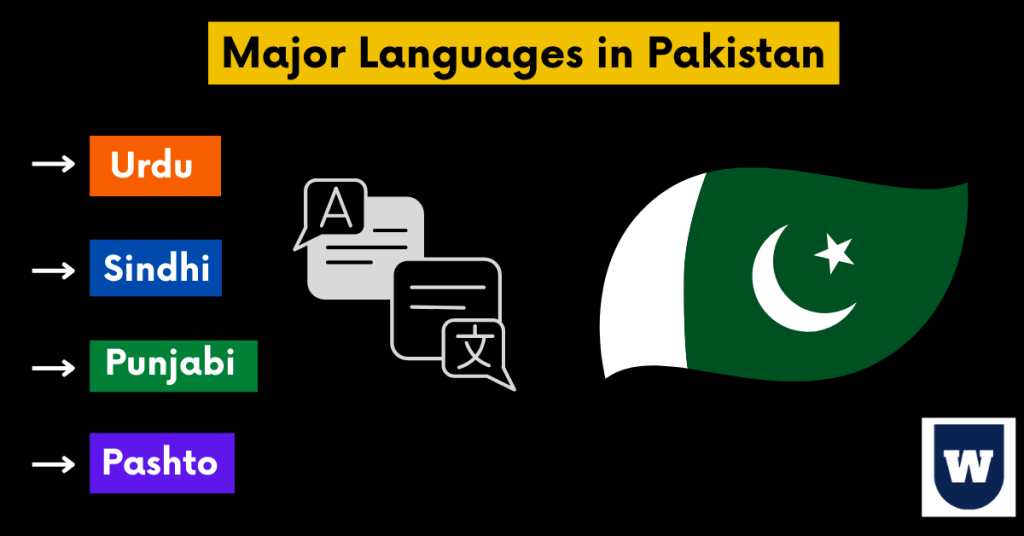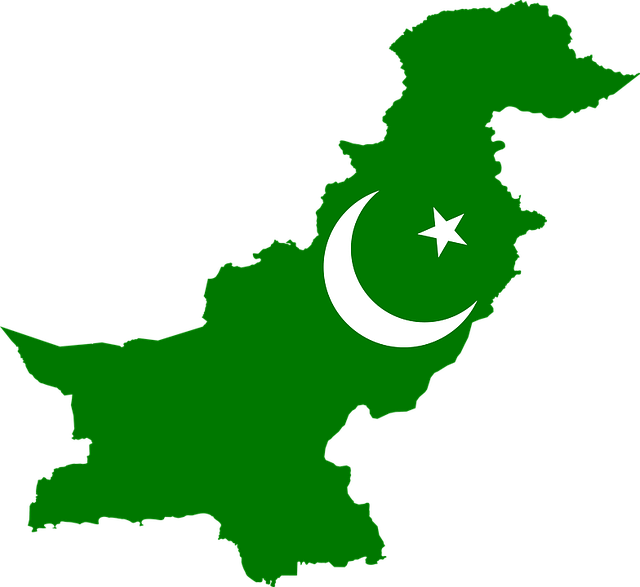If you want to know about the major languages in Pakistan, you will love this in-depth guide.
But first, let’s start with a simple introduction.
Quick fact: There are between 70 and 80 languages spoken in Pakistan. Amazing, isn’t it?
What is a Language:
In simple words, it is a mode of communication.
It is a way through which people transmit their ideas and emotions. Over here, let me share something interesting with you.
There are around 7,151 languages spoken today around the world.
Language is not only restricted to speaking. It refers to other forms of communication as well. For example, language is people using their hands to express themselves.
Before moving on to the next topic, here are some of the major languages in Pakistan.
| Language | Percentage of people |
|---|---|
| Urdu | 10% (national language of Pakistan) |
| Sindhi | 12% |
| Punjabi | 48% |
| Saraiki | 10% |
| Pashto | 8% |
| Balochi | 3% |
| Hindko | 2% |
Now, let’s talk about them in detail.
Major Languages in Pakistan:
Here’s what you should know.
Overview: The people of Pakistan speak between 70 and 80 languages. Amazing, isn’t it? Urdu (national language of Pakistan) , Pashto, Balochi, Sindhi and Punjabi are some the major languages in Pakistan. In addition, Bengali, Kashmiri and Saraiki are some popular languages of Pakistan as well.
Urdu:
Urdu is the national language of Pakistan.
Now you might be wondering, why was Urdu selected as the national language of Pakistan?
Let me explain.
- The history.
If we talk about this language, it was used by Muslims from dates back up to the Sultans of Delhi. Then, it was used by Mughal emperors as well.

The best part?
It was also used by the Muslim troops in the British army. This reflected the association of Urdu with Muslims.
- The rich literary background.
Urdu was a language chosen by the prominent personalities of the subcontinent.
Let me explian.
These include Maulana Shibli Naumani, Mir, Dard, Altaf Hussain Hali, Allama Iqbal, and others. The work of these influential personalties for Urdu in poetry and prose was highly appreciated.
Plus, they promoted the Urdu language as well.
- The close association of Urdu with Islam.
Pakistan is a Muslim country.
The Holy Quran had been translated to Urdu. Similarly, many other Islamic books were also translated to Urdu.
The takeaway for you is that Urdu had a close association with the Muslims.
- The independence of Pakistan.
Here’s what you should know.
Muhammad Ali Jinnah (the first governor-general of Pakistan) wanted Urdu to be the national language of Pakistan.
Since the people of Pakistan adored his contributions, they respected his decision as well.
When the Muslims league was formed in 1906, one of its objectives was the protection of Urdu as well. This shows its importance as a language.
In short, Urdu promoted nationalism among Muslims which was vital for them to achieve independence. As a result, it became the national language of Pakistan.
Pretty simple, isnt it?
Government efforts to promote Urdu after independence:
As I mentioned earlier, around 10% of the population in Pakistan speaks Urdu.
The question is, how did the government promote Urdu? Here’s what you should know.
- Films, magazines, dramas, and novels were published.
- It became a medium in schools, colleges and universities.
- Its study was made compulsory in educational institutions.
To summarise, Urdu is one of the most popular members of the Indo-European family of languages.
Now, let me introduce other languages of Pakistan.
Sindhi:
This language is used by the people in the South-Eastern part of Pakistan, majorly in Sindh.
Let me tell you that the Sindhi language has an exceptional past.
As the Persians, Turks (Turkish), Romans and British came into the subcontinent, the Sindhi language became a mixture of Persian, Turkish, English, Sanskrit and Arabic.

This ancient Indo-Aryan language is spoken by millions of people in Pakistan.
Note that the Sindhi literature was massively promoted by figures such as Shah Abdul Latif Bhitai and Sachal Sarmast.
Government efforts to promote Sindhi after independence:
- In 1948, a Sindh Literary Board was set up to make magazines and books in Sindhi.
- Books and magazines were also published in Sindhi.
- In 1954, Bazm-e-Talib-ul Maula was set up to promote Sindhi.
In Sindh, it was also ensured that Sindhi was taught in educational institutions.
Amazing, isnt it?
Balochi:
Balochi is spoken in South-West (mainly Balochistan) and some areas of Kashmir.
Note that it is spoken in Afghanistan and Iran as well.
According to multiple sources, the Perso-Arabic script was adopted by the Baloch scholars to write Balochi.
Here’s something interesting.
Balochi is divided into different dialects:
- Eastern Balochi: Spoken in Afghanistan and Iran.
- Western Balochi: Spoken in coastal areas of Balochistan
- Northern Balochi: Spoken in upper and central Balochistan
- Southern Balochi: Spoken in lower Balochistan
If we talk about the government efforts to promote Balochi after partition, the Balochi literary association board was set up.
This board promoted Balochi through the publishing of various magazines and books. Moreover, the radio Pakistan Karachi and the Quetta Radio station began to broadcast in Balochi as well.
You should note that people such as Atta Shad and Gul Khan Nazir worked tirelessly to promote Balochi.
Punjabi:
As I mentioned earlier, around 70 million people speak this language in Pakistan.
Amazing, isn’t it?
Let me introduce punjabi language to you.
Punjabi is the most spoken language of Pakistan. Apart from Punjab, the people of KPK and Kashmir use it as well.
Now you might be wondering, what made it popular?
This language is influenced by Arabic, Persian, Hindi, and several other languages. Initially, folk tales such as ‘Heer Ranjha’, ‘Sohni Mahival’, and ‘Sassi Pannu’ were published in Punjabi.
After that, Sufi poets such as Baba Farid Ganj Shakar and Baba Bulle Shah promoted Punjabi as well.
Government efforts to promote Punjabi:
- Books, novels, and magazines were published.
- It started as a subject in schools and new mediums such as ghazal and nazam emerged.
- Ustad Daman and Gul Khan Nazir worked hard for the widespread of Punjabi.
Now, let’s talk about pashto.
Pashto:
This language is widely spoken in the North-West of Pakistan.
Note that it is an important member of southeastern Iranian branch of Indo-Iranian languages. We can divide pashto into three main regional varieties:
- Northern Pashto
- Southern Pashto
- Central Pashto
The emergence of Pashto can be divided into three periods.
The period between the second and thirteenth century.
In this time, famous poets were Amir Khan Pehivan and Bayazid Ansari. They produced masterpieces on Sufism.
The next era is the Mughal empire.
Punjabi massively became popular in this time. This was due to the work of eminent personalities such as Hazrat Mian Umar, Saadat Ali Khan, and Amir Muhammad Ansari.
The third stage is the era of British rule in the subcontinent.
At this stage, famous personalities that worked for Pashto were Rehman Baba and Khushal Khan Khattak.
Further reading:
Round Table Conferences | 1930-1932 | The Ultimate Guide
How Did Bangladesh Gain Freedom From Pakistan
If we talk about the government efforts to promote Pashto after partition, Peshawar university was set up in 1954.
Due to the efforts of Sahibzada Abdul Qayyum, Pashto gained a massive boost.
Wrapping Up:
With this, our topic about the major languages in Pakistan is covered.
In addition to the above-listed languages, Bengali, Kashmiri and Shina are some popular languages of Pakistan as well.
If you have any questions, feel free to get in touch. Thank you for reading.
Stay tuned for more.

Great
Appreciate it Jahangir